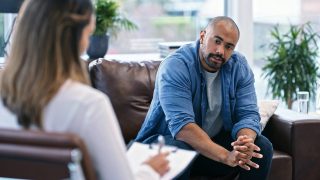
Law enforcement professionals read human behavior and predict what actions to take. This matters the most within the context of a use-of-force event. It is a well-established standard that officers are not required to make perfect predictions; rather, they are required to make reasonable predictions. An area of difficulty for most officers is articulating why certain observed behaviors led the officer to reasonably predict potential violence.
One way an officer can articulate how their prediction of human behavior was reasonable is to become aware of research that has found certain behaviors to be associated with human violence. Accordingly, let us now explore peer-reviewed research and determine what conclusions we can reach.
An area of difficulty for most officers is articulating why certain observed behaviors led the officer to reasonably predict potential violence.
Facial signs of imminent aggression
Researchers found that humans can reasonably identify facial expressions associated with potential violence. This research involved several police officers and civilians, all of whom participated by viewing static facial expressions associated with violence. Participants were asked to select photographs that most resembled a face associated with violence.
Researchers found facial expressions of anger are associated with potential aggression, and humans perform quite well at detecting facial expressions most likely to lead to violence. These facial features include (tinyurl.com/ycx4ykfe):
- Furrowed brows
- Tightened lips
- Clenched jaw
- Staring
Adults’ beliefs regarding nonverbal cues predictive of violence
Researchers published their findings regarding what behaviors adults view as indicators of violence. Their study involved participants completing a set of questions based on a scenario. The top five behaviors that they associated with potential violence included (tinyurl.com/mu5z8r3d):
- Invading personal space
- Taking a boxing stance
- Making verbal threats
- Clenching hands
- Glancing around
Law enforcement officers’ perceptions of nonverbal behavior and violence
Researchers sought to determine whether there were differences between law enforcement and civilian perceptions of violent indicators. What is of particular significance for this article is what behaviors were viewed as most likely associated with “fight or flight.” These behaviors included (tinyurl.com/6pbxksey):
- Invading personal space
- Taking a boxing stance
- Clenching hands
- Stretching arms and shoulders
- Angry expressions
- Exaggerated gestures
Notably, there were two behaviors that law enforcement and civilians viewed differently regarding severity. Law enforcement viewed a boxing stance as more concerning than civilians, whereas civilians viewed angry expressions as more concerning than law enforcement. The researchers speculated that law enforcement officers might be more accustomed to observing angry expressions and, therefore, viewed them as less concerning.
Exploring the validity of behavioral cues predictive of physically resisting arrest
Researchers viewed 174 re-corded arrests to identify the arrestee’s behavior prior to being arrested. They specifically sought to determine whether taking a fighter’s stance, invading personal space, placing their hands in pockets, clenching their hands, making hostile comments, pacing, glaring, looking around and stretching their arms and neck were associated with resisting the arrest. They found that only four behaviors were statistically relevant to potential violence (tinyurl.com/y5rjacts):
- Invading personal space
- Taking a fighting stance
- Clenched fists
- Placing hands in pockets
Misinterpreting danger? Stereotype threat, pre-attack indicators and police–citizen interactions
This research is of significant value to law enforcement. Researchers note that when a person experiences the emotion of fear, certain behaviors can occur that mimic aggression. This is called stereotype threat, which can occur when an individual feels judged or perceived as being treated negatively based on belonging to a particular social group. Law enforcement must be keenly aware of this, as human behavior should be considered within the context of the overall event. Police officers recognize this requirement through the term “totality of the circumstances.” Researchers found that the following behaviors may be caused by fear and not aggression (tinyurl.com/yc375kup):
- Clenching fists
- Scanning the scene
- Fidgeting
- Pacing
- Clenching jaw
- Shifting weight
- Removing clothing
The authors underscored their research should not diminish police officer safety. Rather, their intent was to merely bring awareness to the fact that an innocent person who is afraid may display some of these behaviors and have no intention of violence. Officers who use force because they incorrectly interpret these behaviors as an attack could lead to a negative yet avoidable outcome. Context is key to not only properly predicting aggression but also articulating your prediction’s reasonableness.
Show me your hands! Police and public perceptions of violent interpersonal cues
Researchers wanted to compare the perception of behaviors associated with imminent violence between law enforcement and civilians. The research involved both groups rating 23 behaviors based on their perceived level of concern after reading a given scenario. Some of the most concerning behaviors for the civilian group included (tinyurl.com/2yc6my7e):
- Invading personal space
- Taking a boxing stance
- Clenched hands
- Making threats
- Tense jaw
Both groups agreed that a boxing stance and invading personal space were the top two most concerning behaviors. One area of interest regarding a difference between the two groups was the behavior of placing hands in pockets. Law enforcement perceived this as higher, whereas civilians viewed this behavior as less concerning with regard to violence.
Conclusion
One could conclude that humans are quite good at accurately predicting potential violence. Research suggests that behaviors such as invading personal space, taking a fighting stance, clenching the hands and tightening the jaw are accurate predictors of potential violence. Finally, officers must consider the overall circumstances to put the observed behaviors into context. Some of the same behaviors that are indicators of violence may also be indicators of stress associated with fear. Context is key to framing the observed behavior helping to articulate why the officer’s prediction of violence was reasonable.
Most law enforcement professionals already know what this research has found. The key to being a true professional is to support your personal experiences with research, thus helping your prediction of violence to be reasonable and articulated in a manner that others can understand.
I encourage you to read the sources cited throughout this article so that you can draw your own conclusions. cited above so that you can draw your own conclusions. Do not take my opinion alone without doing your own research.
As seen in the February 2023 issue of American Police Beat magazine.
Don’t miss out on another issue today! Click below:





